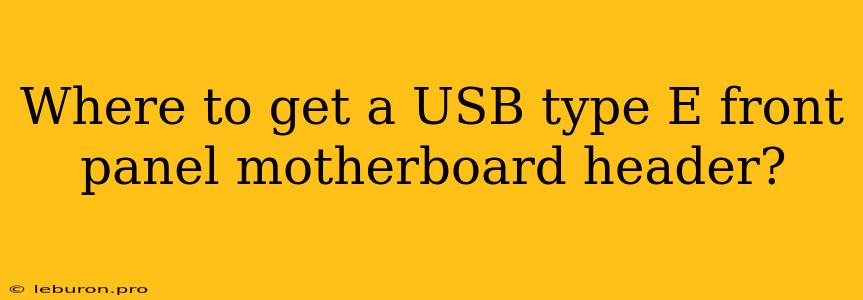The USB Type-E connector, also known as the USB4 Type-E connector, is the latest addition to the USB family. It boasts impressive speeds, power delivery capabilities, and a sleek, compact design. While USB Type-E is still relatively new, you might find yourself wanting to integrate this cutting-edge technology into your PC build, particularly for achieving high-speed data transfer rates. This leads to a common question: where can you find a motherboard with a USB Type-E front panel header?
The Current Landscape of USB Type-E
The challenge lies in the fact that USB Type-E adoption is still in its early stages. While the standard has been released, its widespread implementation in motherboards hasn't yet materialized. This means that you're unlikely to find a standard motherboard with a dedicated front panel header for USB Type-E right now.
Why is This The Case?
- New Technology: USB Type-E is a relatively recent development, and motherboard manufacturers need time to integrate it into their designs.
- Limited Demand: As USB Type-E devices are not yet commonplace, the demand for front panel headers hasn't reached a critical point for widespread adoption.
- Manufacturing Challenges: Implementing USB Type-E headers requires new manufacturing processes and components, which may present challenges for some manufacturers.
Potential Solutions for USB Type-E Front Panel Integration
Even though finding a motherboard with a built-in USB Type-E header might be challenging, there are several potential solutions for adding this functionality to your PC:
1. Wait for Widespread Adoption
The most straightforward solution is to simply wait. As USB Type-E devices become more popular and the technology matures, we can expect to see more motherboards featuring dedicated front panel headers.
2. Utilize PCIe Expansion Cards
While motherboards might not have dedicated USB Type-E headers, some manufacturers are releasing PCIe expansion cards with USB Type-E ports. These cards can add USB Type-E connectivity to your system without requiring a front panel header on the motherboard itself.
3. Consider Custom Build Options
For those seeking a more advanced solution, you could explore custom PC building with a motherboard featuring a built-in USB Type-E header. Some specialized manufacturers might offer this option, but it's important to research and contact potential vendors for availability.
4. Explore Adapters
In the meantime, you can consider using adapters. Although not ideal, an adapter could allow you to connect USB Type-E devices to a standard USB Type-C or Type-A port on your motherboard or case.
Important Considerations
- Compatibility: If you are considering a PCIe expansion card or a custom build, ensure that the components are compatible with each other and your existing hardware.
- Driver Support: It's crucial to verify that your operating system has the necessary drivers for USB Type-E devices before purchasing any components.
- Future-Proofing: While USB Type-E is a promising technology, it's still relatively early. Keep in mind that future developments could potentially make this technology obsolete, although it's unlikely in the short term.
The Future of USB Type-E
While USB Type-E is still in its early stages, its potential is undeniable. The technology offers a significant leap in speed, power delivery, and design, making it a compelling alternative for future generations of devices. As adoption increases and manufacturers embrace its benefits, we can expect to see more widespread availability of motherboards with USB Type-E front panel headers.
Conclusion
For the time being, finding a motherboard with a USB Type-E front panel header might be difficult. However, with the advancements in technology and the increasing popularity of USB Type-E, we can anticipate its widespread adoption in the future. If you're eager to embrace this cutting-edge technology, consider the alternative solutions discussed above or wait patiently for the technology to become more mainstream. As the technology matures, the possibilities for USB Type-E integration in PC builds will expand significantly, offering an even greater range of options for users seeking high-performance connectivity.
